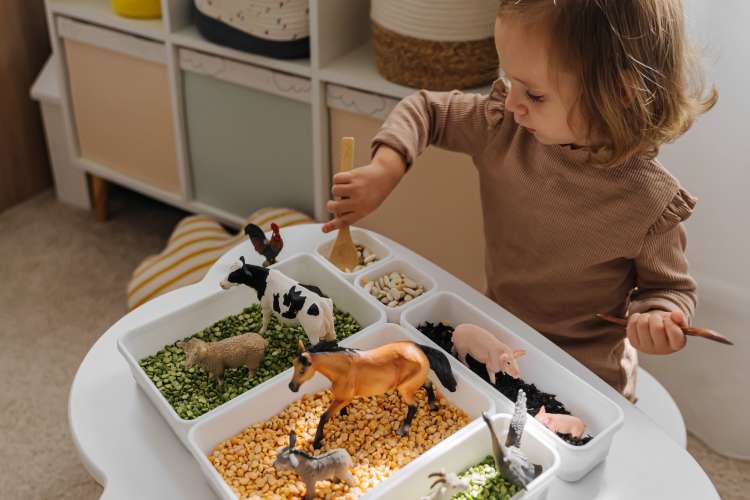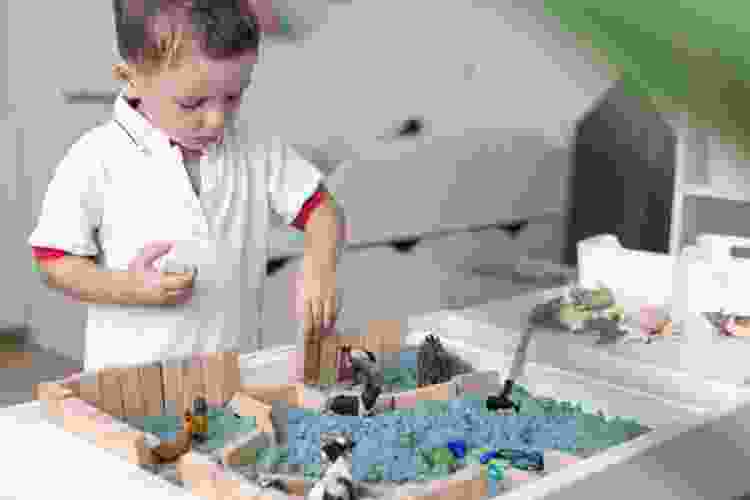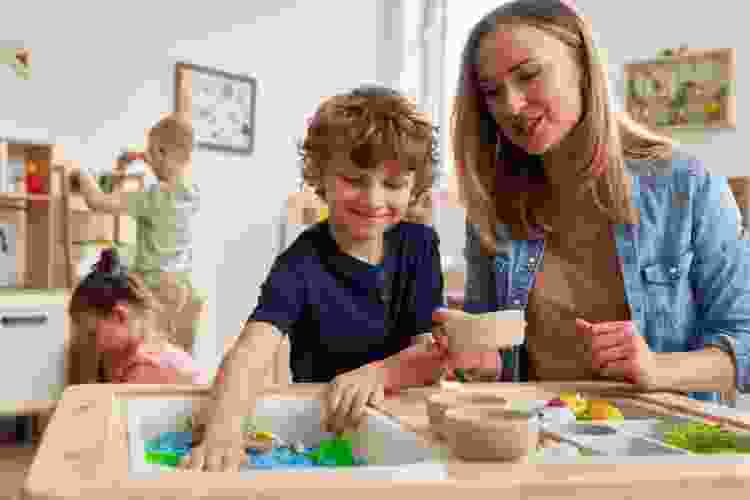35 Sensory Bins That Make Hands-On Play Fun in 2025

Sensory bins might look like simple playtime, but they’re actually powerful tools for learning and development. These hands-on activities help kids build skills like fine motor coordination, language and even emotional regulation — all while keeping them engaged. Sensory bins work for a wide range of ages and the best part is they’re easy to make at home with just a few everyday materials.
For instance, activities like scooping, pouring and manipulating small objects in sensory bins can strengthen hand muscles and improve fine motor skills, which are essential for tasks like writing and buttoning clothes.
Jump to Section
- What Are Sensory Bins?
- The Benefits of Sensory Play
- How to Make a Sensory Bin
- Sensory Bin Ideas by Age
- Seasonal and Themed Sensory Bin Ideas
- Tips for Budget-Friendly Sensory Bins
- Sensory Bins FAQs
What Are Sensory Bins?
Sensory bins are a way for kids to explore through touch, sight, sound and even smell. They’re usually made with a low container filled with a textured base like rice, sand or water, plus a few tools and toys to scoop, pour or dig. That simple setup encourages kids to play freely while learning through their senses.
They’re especially helpful for practicing focus, coordination and communication. Instead of following steps like with winter crafts for kids, or just getting a laugh from jokes for kids, sensory bins invite hands-on discovery that builds real-world skills while keeping things fun.
The Benefits of Sensory Play
Sensory bins aren’t just something to fill a rainy afternoon. They’re a clever way to sneak real learning into everyday play, without turning it into a lesson. With just a few scoops of rice and some kitchen tools, you’ve got a hands-on experience that supports everything from fine motor skills to language.
1. Boost Cognitive Development

Give kids a pile of pom-poms and they’ll sort them by color without even being asked. Count scoops of lentils into a cup, compare the size of buttons or hide foam numbers and letters for them to find. Suddenly, they’re working on early math and literacy skills — and loving it.
2. Build Fine Motor Skills
Scooping, pouring, pinching and stirring might not look like much, but these tiny movements strengthen the same muscles needed for self-feeding, dressing and writing. Toss in some large tweezers, a mini funnel or a slotted spoon and they’ll get to practice different grips without even realizing it.
3. Foster Social and Cooperative Play
When shared with siblings or friends, sensory bins become a powerful tool for teaching cooperation. When kids play together, they learn to wait for a turn with the scoop, build a pretend ice cream shop or sort things into categories as a team. It’s the kind of play that builds patience and cooperation in a subtle, natural way.
4. Stimulate the Senses

A sensory bin engages multiple senses at once, from cool rice slipping through fingers to the thunk of beans in a metal bowl. Add cinnamon sticks or lavender and you’ve introduced scent in a safe, natural way. These little moments help kids make sense of the world and develop stronger sensory awareness over time.
5. Provide a Calming Activity
Running hands through a sensory bin can help calm an overwhelmed child. For kids who are overstimulated or just need a reset, the quiet, repetitive nature of sensory play can bring their energy down in a way few other activities can. The simple motions of scooping, pouring or sorting can ease tension and create a sense of calm, especially during transitions or after a long school day. These rhythmic movements have been shown to reduce anxiety, increase focus and promote relaxation.
6. Support Language Growth
Sensory bins invite conversation. As kids explore, talk with them about what they’re doing: “You’re filling the red scoop,” or “That’s a soft, squishy sponge.” Use words like full, empty, bumpy or hidden. These back-and-forth chats help expand vocabulary and reinforce early language concepts.
How to Make a Sensory Bin
You do not need much to pull together a great sensory bin. Start with a shallow container and add a base material — rice, lentils, kinetic sand or whatever you have on hand. Then add a few tools or toys for scooping, pouring or sorting.
There are just a few things to keep in mind:
-
Watch for choking hazards. For younger kids, skip anything small enough to fit in their mouths.
-
Keep it age-appropriate. A toddler doesn't need a themed bin with five steps — a handful of rice and a spoon will do.
-
Use what you do not mind losing. These bins are meant to be explored. Stick with durable materials or items that are easy to replace.
Sensory Bin Ideas by Age
Sensory play looks different at every stage, but the goal stays the same: hands-on exploration that actually helps kids grow. These ideas are easy to pull together and fun to tweak with what you already have.
Sensory Bins for Babies
1. Water and Sponge Bin

Warm water, soft sponges and the simple joy of squeezing and splashing. It is all about the way water drips, swirls and catches the light — and those little hands can’t get enough.
2. Oatmeal Texture Bin
Dry baby oatmeal feels soft, safe and just a little bit messy. Add silicone spoons and plastic rings and you’ve got a bin that’s made for mouthing, grabbing and exploring.
3. Frozen Toy Bag Bin
Cool teethers tucked into zippered bags turn chilly play into something exciting. It soothes sore gums and starts to teach that actions have outcomes, like what happens when you push, pull or bite.
4. Crinkle and Fabric Bin

The sound of crinkly fabric, the feel of fleece, the shimmer of ribbon — this one’s all about variety. Babies kick, reach and wiggle their way through it, taking in new textures and sounds as they go.
5. Foil and Soft Ball Bin
A little light, a little texture and a lot of contrast. Foil crumples and catches the eye, plush balls are easy to grab and wooden rings add something smooth and solid to the mix.
6. Mirror and Rattle Bin
Babies love seeing their own reflection. Add a few soft rattles and suddenly this sensory bin becomes a place to shake, babble and bang while figuring out what’s real and what isn't.
Sensory Bins for a 1-Year-Old
7. Cooked Pasta Bin

Cool spaghetti feels squishy, slippery and completely irresistible. A little oil and a few measuring spoons turn it into the perfect setup for grabbing, stretching and scooping — great for building finger strength and coordination.
8. Cereal Scoop Bin
O-shaped cereal offers just the right texture for early fingers. Add big scoops or stacking cups and it becomes a simple way to practice grasping, pouring and hand control (plus, it’s edible).
9. Water Play Bin with Ducks
A shallow tub of water with floating ducks, cups and ladles invites splashing, scooping and pouring. It’s a simple way to introduce cause and effect while supporting sensory exploration through movement.
10. Pom-Pom and Muffin Tin Bin

Soft pom-poms and a muffin tin make for an easy sorting activity. Picking up, placing and removing the pom-poms encourages concentration and strengthens hand-eye coordination.
11. Dry Beans and Cup Bin
Large lima beans paired with plastic cups or containers are a toddler favorite. They love shaking, pouring and hearing the sound the beans make. It’s a great sensory and auditory experience.
12. Texture Block Bin
Include soft blocks, silicone brushes and textured balls offer just enough variety to keep little hands busy. Exploring different shapes and surfaces helps toddlers get used to new sensations while practicing how to hold and move different objects.
Sensory Bins for Toddlers
13. Farmyard Bin

Dried corn kernels make a fun, crunchy base for toy animals and a scoop. Toddlers can pretend to feed the animals or dig for “seeds,” mixing sensory exploration with imaginative play.
14. Bubble Foam Car Wash Bin
Foamy bubbles and toy cars are always a hit. Add in a sponge and you’ve got a bin that encourages scrubbing, rinsing and storytelling — all while building fine motor control.
15. Color Sorting Bin
Dyed rice paired with colored cups or scoops turns this into a matching game. It’s a simple way to practice color recognition, naming and sorting skills.
16. Treasure Hunt Bin

Kinetic sand hides chunky gems or plastic coins just under the surface. Scooping, digging and discovering keep toddlers engaged while strengthening hand coordination.
17. Ocean Bin
A sea of blue water beads or pasta sets the stage for toy fish and sea creatures. It’s a fun way to build vocabulary and introduce animal names and habitats.
18. Garden Sensory Bin
Potting soil or shredded paper becomes a mini garden when paired with fake flowers, small pots and kid-sized tools. Toddlers can “plant,” “pick” and talk about nature as they go.
Sensory Bins for Kids
19. Construction Zone Bin

Kinetic sand or pea gravel turns into a mini job site with toy trucks and cones. Kids can scoop, haul and flatten their “roads,” building small motor skills and sparking big stories.
20. Alphabet Soup Bin
A tub of water with floating foam letters and ladles turns learning into play. Kids can scoop out letters, identify them and even start forming short words.
21. Dinosaur Dig Bin
Coffee grounds or crumpled paper make the perfect terrain for buried bones and tiny dinosaurs. Add a brush or scoop and you’ve got a full-blown excavation that builds focus and hand control.
22. Arctic Ice Bin

Frozen toy animals turn a bin of water into an icy adventure. Use salt or droppers to help melt the cubes, combining science fun with fine motor practice.
23. Space Bin
Black beans make a great starry sky for glow-in-the-dark planets and astronauts. Toddlers can orbit their own universe while learning new words and making up space stories.
24. Magic Potion Bin
Glitter, colored water, funnels and jars set the stage for all kinds of “potions.” Pouring and mixing support hand control and color recognition, while the sparkle adds a bit of magic.
Sensory Bins for Adults
Sensory bins are the at-home answer to a hands-on art class. They offer a simple, low-pressure way to unwind, focus and stay creative. If you’re looking to explore more, you might enjoy art classes in the Bay Area, art classes in San Diego, art classes in Dallas or take a look at online art classes.
25. Zen Sand Bin

A shallow tray of fine sand, a small rake and a few smooth stones can go a long way. Drawing simple patterns can help you slow down and refocus.
26. Aromatherapy Herb Bin
Dried herbs like lavender, rosemary and chamomile mixed with soft fabrics or beads offer a calming mix of textures and scents. Scoop and blend to create your own soothing sachets.
27. Water Bead Bin
Cool, slippery water beads are oddly satisfying to run your hands through. Add polished stones or marbles for a little extra texture.
28. Clay and Texture Bin

Air-dry clay with some stamps or tools for pressing patterns can be a creative reset. It’s tactile, a little messy and a nice shift away from screens.
29. Mindful Nature Bin
Moss, pinecones, wood slices and smooth pebbles bring a bit of the outdoors inside. The mix of textures and earthy tones makes this one feel grounding and calm.
30. Bead Sorting Bin
Bowls of mixed beads in different colors and textures can be oddly addictive to sort. It’s simple, repetitive and surprisingly grounding.
Seasonal and Themed Sensory Bin Ideas
31. Fall Harvest Bin

Crisp corn kernels, mini pumpkins and a handful of silk leaves give this bin a cozy fall feel. Add a few cinnamon sticks for a warm scent and let little hands scoop and sort through the season.
32. Winter Wonderland Bin
Cotton balls become snowdrifts, with sparkly confetti and polar animals peeking out from a base of cool-toned rice. It’s perfect for chilly-day play with tongs, scoops or just curious fingers.
33. Spring Garden Bin
Bright shredded paper becomes grass, dotted with fake flowers, buzzing bugs and tiny pots to “plant” and “harvest.” It’s part pretend play, part nature talk — and all spring.
34. Beach Day Bin

Soft kinetic sand meets tiny beach toys, seashells and ocean animals. Bury treasures, build mini castles or simply let the grains run between fingers for a relaxing sensory break.
35. Valentine’s Bin
A mix of red and pink rice, heart-shaped gems and small containers make this bin perfect for a themed sort-and-scoop setup. Include a few word cards or letter beads for playful language practice.
Sensory Bins FAQs
What Are Sensory Bins For?

Sensory bins help kids explore the world through touch, sight and sound. While they may look like simple play, they’re actually building blocks for fine motor skills, independent play and early learning.
How To Make a Cheap Sensory Bin?
Start with a shallow storage container and choose a budget-friendly base like rice, pasta or paper shreds. Add measuring spoons, plastic toys or anything else you already have on hand — simple, affordable and effective.
Are Sensory Bins Good for ADHD?
Yes, sensory bins can be helpful for children with ADHD. According to Golden Care Therapy, activities that offer hands-on sensory input — like scooping, pouring or sorting — can support focus, emotional regulation and calm engagement. Sensory bins offer structure without pressure, which makes them a useful option for easing restlessness and building attention in a low-stress way.
What Is the Objective of the Sensory Bin?
At its core, a sensory bin encourages open-ended play. It helps kids get curious, solve problems and build confidence as they explore materials and ideas on their own terms.
Sensory bins aren’t just about keeping little hands busy. They’re calming, creative and surprisingly powerful — the kind of play that supports real growth while still feeling like fun.
For even more hands-on play ideas, check out other experiences happening on Classpop!

